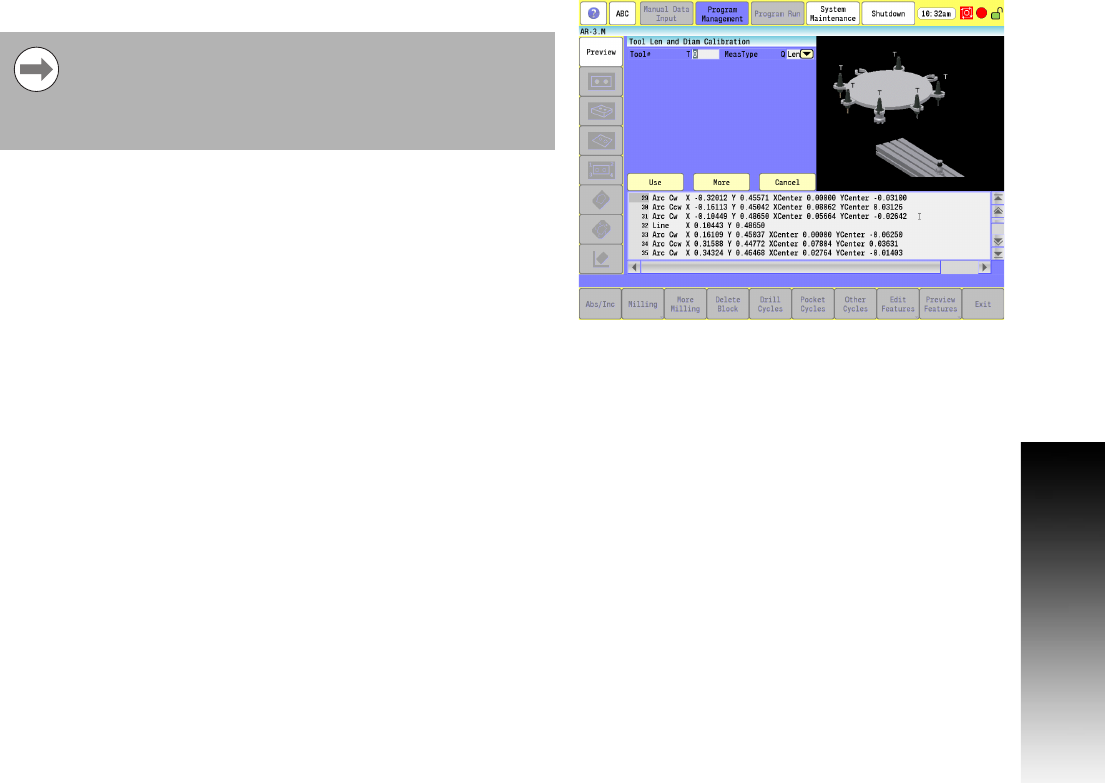Manual
Table Of Contents
- Controls of the 3500i
- Manual Information
- Introduction
- Machining Fundamentals
- Manual Data Input
- Tool Management
- 4.1 Tool Table
- 4.2 Tool Data
- Program Management
- Conversational Editing
- Programming: Canned Cycles, sub-programs
- 7.1 Explaining Basic Cycles
- Round/Chamfer
- Rapid
- Line
- Arc
- Dwell:
- Plane Selection
- Reference Point Return:
- Fixture Offset (Work Coordinate System Select):
- Unit (Inch/MM)
- Dimension (Abs/Inc)
- Absolute Zero Set
- Block Form
- Temporary Path Tolerance
- System Data
- FeedRate
- FeedRate (4th-Axis)
- Spindle RPM
- M - Functions
- Tool Definition and Activation
- Repeat Blocks
- 7.2 Canned Cycles
- 7.3 Probing Cycles
- 7.4 Sub-programs
- 7.1 Explaining Basic Cycles
- Drawing Programs
- Running a Program on the Machine
- CAM: Programming
- 10.1 CAM Programming
- CAM Mode
- Recommended CAM Programming Sequence
- CAM Mode Mouse Operations
- CAM Mode Screen
- Activating CAM Mode
- Creating a New Program
- Tool Path Data Input
- Quick Coordinate Entry
- Job Setup: Basic tab
- Job Setup: Advanced tab
- Comment Tab
- Block Form: Basic tab
- Comment Tab
- Drilling Cycle:
- Drilling dialogue:
- Mill Cycle
- Pocket Cycle
- Pocket Finish Cycles
- Engraving Cycle
- Program Directive
- Modifying Toolbar
- Viewing Tools
- CAM Mode buttons
- CAM Setup
- Geometry
- DXF Import Feature
- Modifying Tools
- Shapes
- Tool Table
- Tool Paths
- CAM Example 1
- CAM Example 2
- 10.1 CAM Programming
- G-Code Edit, Help, & Advanced Features
- 11.1 G-Code Program Editing
- 11.2 G-Code and M-Code Definitions
- 11.3 Edit Help
- 11.4 Advanced Programming
- SPEED
- M - Functions
- Order of Execution
- Programming Non-modal Exact Stop:
- In-Position Mode (Exact Stop Check):
- Contouring Mode (Cutting Mode) :
- Setting Stroke Limit:
- Return from Reference Point:
- Move Reference from Machine Datum:
- Modifiers
- Block Separators
- Tool Offset Modification
- Expressions and Functions
- System Variables
- User Variables
- Variable Programming (Parametric Programming)
- Probe Move (G31)
- Conditional Statements
- Short Form Addressing
- Logical and Comparative Terms
- File Inclusion
- 11.5 Four Axis Programming
- Software Update
- Off-Line Software

ACU-RITE 3500i 203
7.3 Probing Cycles
The Z-axis then does a guarded Z move down 0.1" (2.54 mm) or
whatever amount was placed in the E cycle parameter and then
moves over toward the probe stylus 0.3" (7.62 mm) or until it
touches the probe stylus. If contact is not made with the probe or if
contact is made during a guarded move, then an alarm is generated
and the canned cycle terminates.
After the probe stylus is touched on the first side, the machine then
rapids up and over the stylus, then down on the opposite side, then
over to the other two sides until it has touched the probe stylus on
all four quadrants. This establishes the center of the probe stylus.
The spindle then turns off and the machine touches off on two sides
of the probe with the spindle off finding the effective probe stylus
diameter. Then, rapids up above the probe stylus and over to the
center.
Remove the calibration standard. You are now ready to start running
the G151 to set your tool-length offsets or tool diameter registers.
Tool Length and Diameter Offset Preset
Updates length and diameter tool registers.
Each tool must have the length set once before trying to set the
diameter. Call this cycle up the first time using Q2 because it
automatically sets the length first then the diameter.
Calibrate the tool probe at least once before trying to automatically
preset a tool. This is done initially, but if the stylus is ever changed
or the probe is moved, then you must again calibrate the tool probe
This tool preset (G151) can be run from within a program or from the
Manual Data Input Mode with G-code MDI selected.
If the tool has a hole on the bottom so that the probe
would fall between the tool teeth, do not use this cycle.
Damage to the probe could result. In this case, use G152
for manual length preset or G153 for manual diameter
preset.










